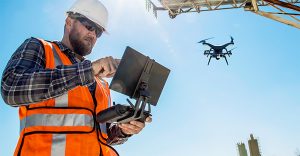Construction has been greatly revolutionized by different technological products released in the past 10 years. And in a lot of our previous blogs, we’ve been talking about how the construction site has become one of the most tech-savvy workplaces at present.
To name a few interesting technologies the industry has been leveraging, construction has been enjoying the benefits of training and inspection with AR (augmented reality wearable) and VR (virtual reality wearable); fabrication of some phases of the building like partitions has been faster thanks to 3D printers heavy workloads became lighter thanks to robots. All these usually long processes became faster because of the presence of automation; management has been more effective because of construction project management software like Pro Crew Schedule
Indeed, the construction industry has been greatly transformed at such a fast pace. Now, drones and unmanned aerial vehicles (UAV) are the next big things in the industry.
Drones in Construction
While most people know drones as tools for hobby and professional photography and videography, these devices have started making their way in construction. Integrated with advanced data analytics and imagery, companies are able to strengthen their infrastructure and optimize their daily business operations with drones as one of their technological investments.
In starting a new project, a wide range of participants are required to successfully complete a project, contractors should be able to bring together all moving parts and make them work as a unified force. Traditional construction firms would do this manually and it’s a great challenge to the project manager to see whether everyone is truly doing their part of the job or not or whether the resources are properly used or not.
With drones added in the equation, contractors and project managers are now able to see the same as the lens, hence making monitoring and inspection more efficient. And with the ability to view from different heights and angles, leaders now literally get a bird’s eye view of their project.
To experience the true potential of drones for construction, you should connect it with your construction management software. This way, the data it gathers as it flies across the parts of the site will be transmitted to your screen in real-time. This allows for seamless collaboration between you and your workers as well as with your clients.
Drones can capture images in a way that no human can do. This creates a holistic picture of the operation. As it’s bound to see greater improvements year after year, it can bring better changes to the construction industry.
How to Use Drones in Construction
If you are not yet using this tech device, it’s time to consider doing so. Here are some ways drones can make an impact on your construction project:
1.More Accurate mapping of the Construction Site
Mapping the construction site is among the first processes and also serves as the first challenge a contractor faces in building a new structure. Whether it’s a building, a dam, a bridge, or a road, it is important to survey the site and its surroundings to make better plans and avoid future litigation.
The process of mapping a site used to be a difficult task. Aerial shots used to be expensive too as firms needed to hire airplanes to take photos of large sites. But with the help of drones, this changed. The process became faster and cheaper.
Most drones used in the construction may cost a thousand or two thousand dollars. But this price is relatively more affordable compared to hiring a private plane. Plus the drone will be yours and you can use it on other projects in the future.
And as the project progresses, contractors can easily get current images to monitor the site and make sure that it isn’t going beyond the boundary. By sending all these images straight to your construction project management software, you can do regular reporting to your client, making them build a stronger trust in you
2.Safer Site Inspection
More than you know, site inspection is among the most dangerous tasks on site. With so many moving parts, construction supervisors face great risk by roaming around to see to it that everything is in order. But thanks to drones, this job has become a lot safer.
Project leaders are now able to do site inspections from the comfort and safety of their office. Since risk factors are eliminated, they can now review the site more efficiently and accurately.
Furthermore, the use of drones is the best way to complete inspections of huge projects like dams and bridges. Drones are also useful during insurance claims, as they are used to provide evidence of construction progress.
3.Risk-Free Surveillance
In carrying out a building survey, accessing the roof can be dangerous and difficult. But with a drone, potential risks of doing building surveillance are eliminated. And since it’s safer, the task can be completed faster.
Drones are making a lot of processes in construction safer, easier, and faster, allowing key players to focus on other important tasks. Costs on claims and rehabilitation due to recovering from injuries will also be minimized if not totally avoided.
4.Better Communication and Management
Like how drones are used for site inspections, they can also be used to manage processes and resources more efficiently. Drone technology, most especially when connected to a construction project management software like Pro Crew Schedule, makes connectivity instant between members. They are used to maintain constant contact within the work site, although most drones only last for a few minutes when operated.
With the ability to send videos to the office in real-time, contractors are able to see what everyone is currently working, allowing them to step in before a mistake happens. Drones also allow contractors to see the current conditions of equipment and supplies, making contractors order reinforcements before they ran out.
Overall, having a better way to manage all of your resources will lead to a sharp increase in the productivity of the whole team. Consequently, delays and cost overrun are decreased.
5.Improved Overall Security
The construction inspectors, contractors, clients, and supervisors aren’t the only ones kept safe by using drones on-site. Members also benefit from the heightened security brought about by drones.Drones can magnify the monitoring and communication features of construction project management software. Members no longer have to walk far or rush to the office to report important matters like an accident or equipment breakdown. With a drone to take shots of the incident and software to communicate the matter, members can do safer reporting, people involved in accidents can be quickly attended to, and faulty machines can be addressed immediately6.Impressive Marketing for Attracting More Clients
Letting possible clients see that your firm is on the latest technology trend will instill an idea in them that you follow higher quality procedures that will ensure the success of their projects. High-end drones capture high-quality aerial images and video footage so that you can create accurate 3D BIM models and renderings that you can use in bidding or an ad. The better visualization they get out of your presentation might just be the deciding factor that will win you a bid.
7.Insight Gathering
Drone images, as we mentioned, generates more accurate 3D BIM models and high-resolution Orthomosaic maps. Project managers are then able to track up-to-date progress on projects, identify mistakes before they create costly setbacks, and trim costs.
Challenges of Employing Drones in Construction
While a drone can offer tons of benefits, there are also some challenges that come with the use of it. Let’s have a quick look at them:
- People assigned on construction inspection should have the technological knowledge to operate them. It may seem like flying a plane toy but to really get high-quality images, they need to train on how to properly fly them. Otherwise, you can crash this sensitive device and instead of gaining from it, you’ll end up losing a thousand dollar investment. Likewise, members should also have the basic knowledge on how to communicate scenes via drones so that they can relay their concerns more clearly to the contractor or project manager.
- Apart from having the right knowledge on using the drone, operators should also know the routes to avoid the device from bumping into posts or equipment that can break it.
- Weather and light are two of the biggest enemies of drones. You can’t fly a drone when it is too windy. Otherwise, the drone may drift away and crash somewhere outside the site. Low light is another disadvantage. Although drones are now equipped with their own light, gathering data at night will never give you a quality image.
Conclusion
A massive increase in the use of drones is inevitable as more businesses realize its full potential. Almost 25% of the construction firms around the world are now considering to use drones as a part of their operation this 2020. As more advances are made in drone technology, it will offer more benefits than the ones we listed and generally become more useful.





